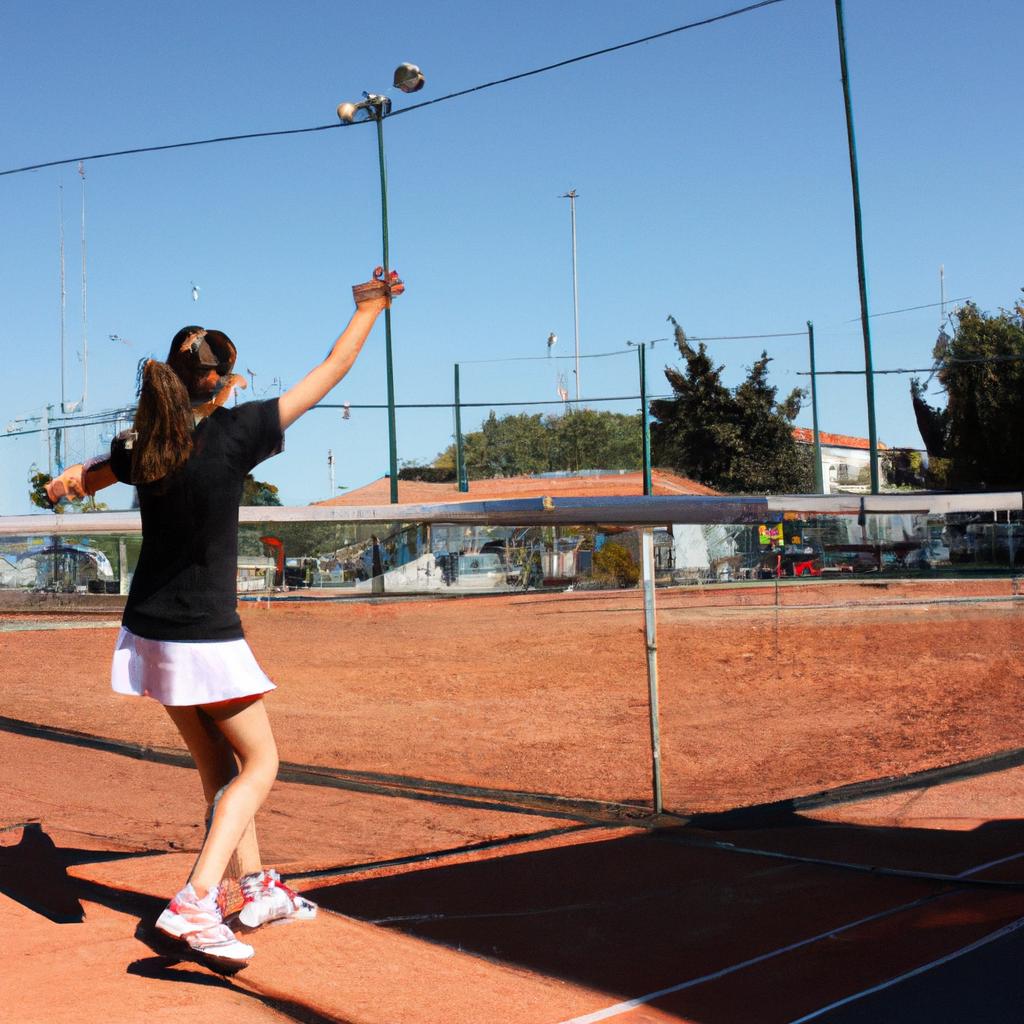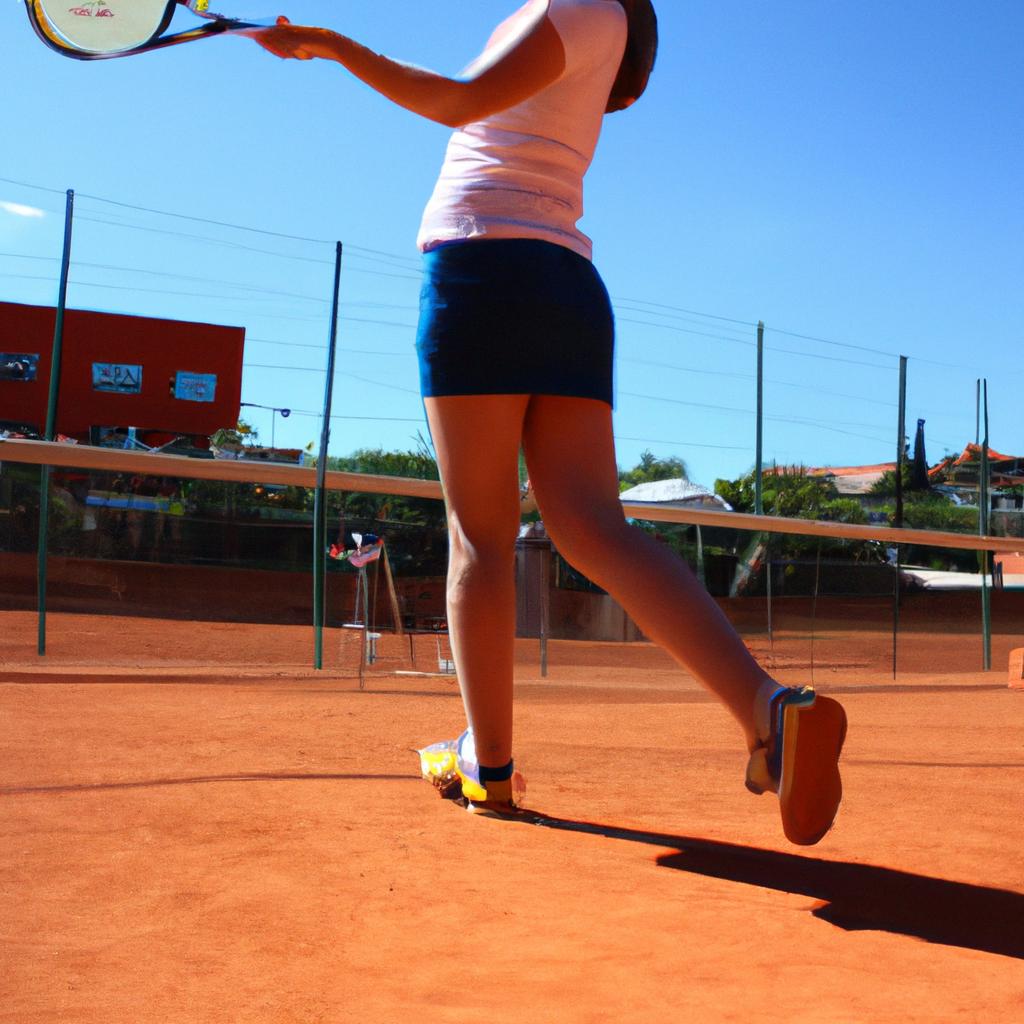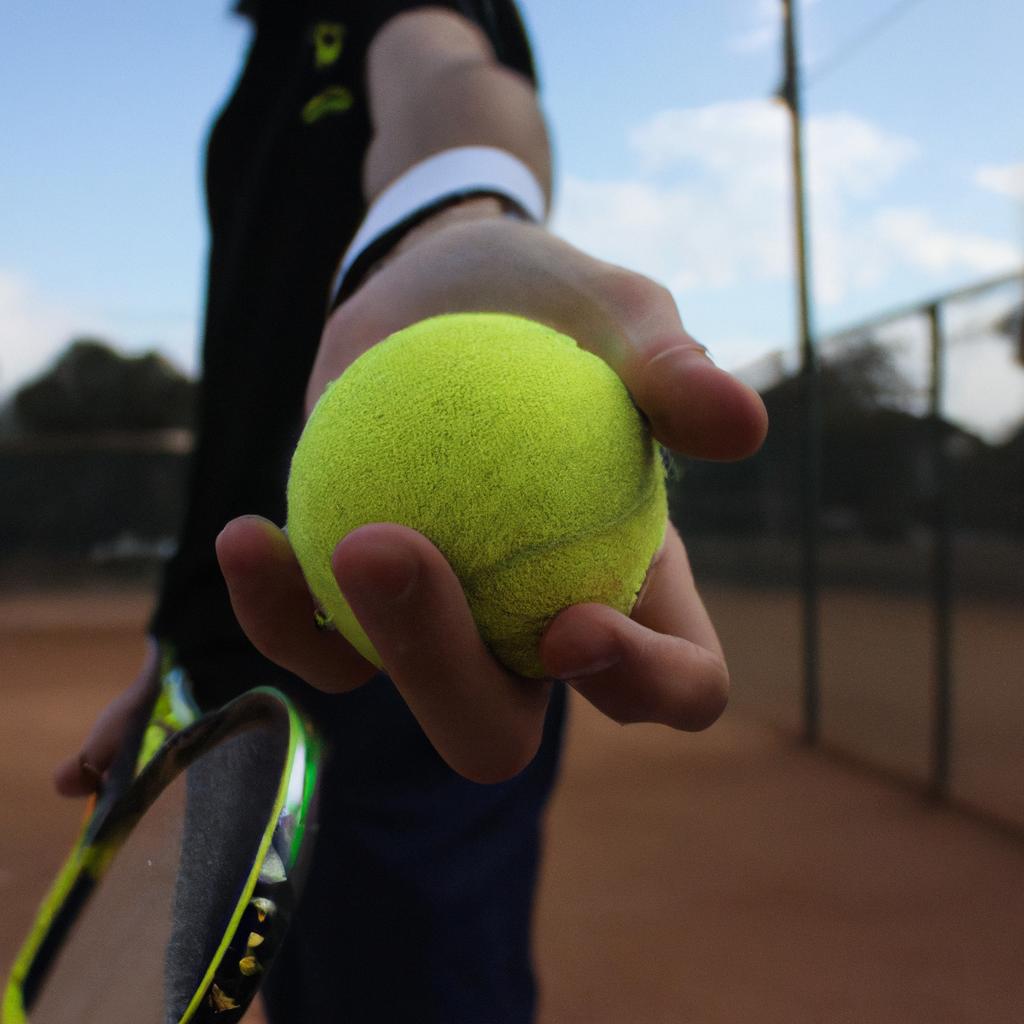Tennis is a popular sport that requires a combination of physical endurance, hand-eye coordination, and strategic thinking. Whether you are a beginner or have some experience on the court, it is essential to develop basic tennis skills in order to excel in this game. In this article, we will explore the fundamental techniques and strategies necessary for success in tennis lessons at Swim & Tennis Club.
Imagine a scenario where Sarah, a novice player with no prior knowledge of tennis, decides to join the local Swim & Tennis Club’s tennis lessons. She arrives at the first session feeling excited but also slightly apprehensive about her lack of experience. However, under the guidance of skilled instructors and by mastering basic tennis skills such as proper grip, footwork, and shot execution, she gradually gains confidence and improves her performance on the court. This example highlights how learning these foundational skills can provide individuals like Sarah with an empowering foundation upon which they can build their tennis abilities.
Tennis Equipment: Essential Gear for Beginners
Imagine you are stepping onto a tennis court for the first time, eagerly gripping your racket and ready to give it your all. Before you can dive into the world of forehands and backhands, it is important to equip yourself with the necessary gear that will enhance your performance and protect you from potential injuries.
To start off, let’s consider the most crucial piece of equipment – the tennis racket. This essential tool comes in various sizes and styles, so it is vital to choose one that suits your playing style and skill level. A beginner-friendly racket typically has a larger head size, providing a larger sweet spot which allows for more forgiving shots. Additionally, rackets made of lightweight materials like graphite or aluminum alloy offer better maneuverability, making them easier to swing.
Next on our list is proper footwear. Tennis involves quick lateral movements and sudden changes in direction, putting strain on your feet and ankles. Investing in a pair of tennis shoes specifically designed for this sport is highly recommended as they provide stability, cushioning, and support during intense matches or practices.
Protective eyewear should not be overlooked when considering tennis equipment. Although often disregarded by beginners, wearing goggles or sunglasses with shatterproof lenses can safeguard your eyes from flying balls or accidental racquet contact. It only takes one incident to realize the importance of protecting these precious organs.
Lastly, don’t forget about hydration! Staying properly hydrated throughout a match or practice session is key to maintaining peak performance and preventing fatigue. Make sure to have a water bottle handy at all times to replenish fluids lost through sweat.
Incorporating an emotional element into our discussion of tennis equipment can enhance its impact on readers:
- A reliable racket empowers players to unleash their full potential.
- Proper footwear provides comfort while striving towards excellence.
- Protective eyewear ensures safety without compromising vision.
- Hydration keeps players refreshed both physically and mentally.
To summarize, when embarking on your tennis journey, it is crucial to equip yourself with the right gear. A suitable racket, appropriate footwear, protective eyewear, and a water bottle are essential items that contribute to an enjoyable and safe playing experience. By investing in quality equipment, you set yourself up for success on the court.
As we transition into the next section about “Grip and Stance: Proper Technique for Holding the Racket,” let’s delve deeper into the technical aspects of playing tennis while maintaining proper form.
Grip and Stance: Proper Technique for Holding the Racket
Essential Gear for Beginners’
Having discussed the necessary equipment to get started with tennis, let us now delve into the fundamental techniques that form the foundation of this sport. Proper grip and stance are crucial elements in achieving a strong and accurate shot. By understanding and implementing these techniques correctly, you will be better equipped to handle various shots during gameplay.
To illustrate the importance of grip and stance, consider a hypothetical scenario where two beginners are learning how to play tennis. Player A holds the racket incorrectly with an improper grip and has a poor stance, while Player B follows proper technique by holding the racket with a correct grip and maintaining a balanced stance. As they attempt their first serve, it becomes evident that Player B’s ball travels over the net smoothly with precision, whereas Player A struggles to maintain control over their shot.
Mastering your grip involves finding a balance between firmness and flexibility. It is essential to hold the racket firmly enough so it does not slip out of your hand upon impact but also flexible enough to allow for smooth maneuverability when executing different strokes. Additionally, adopting an appropriate stance provides stability and enables efficient weight transfer during shots.
To help you grasp these concepts more effectively, here are some key tips:
- Ensure that your dominant hand (right or left) grips the racket naturally.
- Keep your fingers relaxed rather than tense.
- Place your non-dominant hand on top of the grip for added support and control.
- Stand sideways with both feet shoulder-width apart – one foot slightly ahead of the other.
Incorporating proper grip and stance can greatly enhance your performance on court. To further emphasize their significance, consider this table highlighting four benefits associated with mastering these techniques:
| Benefits | Description |
|---|---|
| Enhanced shot accuracy | The right grip and stance contribute to consistent contact with the ball, resulting in accurate shots. |
| Increased power | Proper technique allows for better transfer of energy from the body to the racket, generating more power in your shots. |
| Improved shot control | A correct grip and balanced stance enable players to have greater control over ball placement. |
| Reduced risk of injuries | Using proper techniques minimizes strain on your muscles and joints, reducing the likelihood of injuries. |
Incorporating these aspects into your game will pave the way for success on the tennis court.
Now that you understand the significance of grip and stance, let us explore another essential aspect of tennis – mastering the basic groundstrokes with forehand and backhand techniques.
Forehand and Backhand: Mastering the Basic Groundstrokes
Building on the proper grip and stance, let’s now delve into the fundamental groundstrokes of tennis. By mastering these shots, players can gain better control over the ball and improve their overall performance on the court.
To illustrate the significance of well-executed groundstrokes, consider a hypothetical scenario where two players with different skill levels face each other in a match. Player A consistently hits powerful forehands that land deep in Player B’s side of the court, putting them under constant pressure. In contrast, Player B struggles to execute accurate backhands, resulting in many unforced errors and missed opportunities. This case study highlights how developing strong groundstroke techniques can make all the difference in a game.
When it comes to executing effective forehands and backhands, there are several key principles to keep in mind:
- Proper footwork is essential for positioning yourself correctly before making contact with the ball.
- Maintaining good body balance throughout your stroke will enhance both power and accuracy.
- The timing of your swing is crucial; try to meet the ball at its highest point to maximize control.
- Follow-through is equally important – extending your arm fully after striking the ball ensures a smoother shot delivery.
By following these guidelines consistently, you can develop consistency and build confidence in your groundstrokes. Incorporate regular practice sessions focusing on technique drills that emphasize footwork, body rotation, and racquet head speed.
Emphasizing technical aspects alone may seem dry or overwhelming at times. Here’s an engaging bullet-point list showcasing additional benefits that come from mastering these basic groundstrokes:
- Increased self-esteem as you witness improvements in your gameplay
- Enhanced agility due to improved footwork coordination
- Greater understanding of court positioning leading to strategic advantages
- Development of mental discipline through focus on precision and technique
In addition to grasping these concepts intellectually, visual aids can be helpful in reinforcing the information. Take a look at this table, which highlights the main differences between forehand and backhand groundstrokes:
| Forehand | Backhand | |
|---|---|---|
| Grip | Eastern/Western | Continental |
| Swing Path | Low to High | Straight/Loopy |
| Dominant | Right Hand (RH) | Left Hand (LH) |
| Topspin | Easier to generate | More challenging |
By understanding these distinctions and practicing accordingly, you will gradually refine your groundstroke techniques, leading us closer to our next section on “Serve and Return: Strategies for Starting and Responding to a Point.” This upcoming segment will explore tactics that maximize your chances of success during different stages of a tennis match.
Serve and Return: Strategies for Starting and Responding to a Point
Imagine this scenario: You are on the tennis court, facing your opponent. The game begins and you prepare to hit the ball with a powerful forehand stroke. As you swing your racket, you feel a surge of confidence knowing that you have mastered the basic groundstrokes. In this section, we will delve deeper into these essential skills, focusing not only on the forehand and backhand strokes but also on strategies for starting and responding to points.
To truly excel at tennis, it is crucial to develop a solid foundation in both forehand and backhand techniques. Let’s start by examining each stroke individually:
-
Forehand Stroke:
- Grip: Use an Eastern or Semi-Western grip for optimal control.
- Stance: Stand sideways with your non-dominant shoulder facing the net.
- Swing Path: Rotate your body while extending your arm forward, making contact with the ball out in front of your body.
- Follow-through: Finish with your racket high above your shoulder.
-
Backhand Stroke:
- Grip: Utilize either a one-handed or two-handed grip based on personal preference.
- Stance: Position yourself slightly open, with your dominant foot closer to the net.
- Swing Path: Keep your eye on the ball as you rotate and bring your racket from low to high.
- Follow-through: Extend your arm fully after hitting the ball to generate power.
Now that you understand the mechanics of these groundstrokes, let’s explore some effective strategies for initiating and responding to points:
- Anticipate Your Opponent’s Shots
- Focus on Placement Rather Than Power
- Mix Up Your Shots (e.g., cross-court, down-the-line)
- Stay Balanced and Ready to Move
Emotions can play a significant role in any sport, including tennis. Consider the following table, which highlights some common emotional responses during a tennis match:
| Emotional Response | Description | Example |
|---|---|---|
| Frustration | Feeling annoyed or discouraged by mistakes | Missing an easy shot and expressing frustration |
| Excitement | Experiencing joy or enthusiasm | Celebrating a well-executed winning shot |
| Determination | Showing strong resolve to achieve success | Bouncing back after losing a point |
| Confidence | Believing in one’s abilities and feeling assured | Approaching each stroke with self-assuredness |
In conclusion, mastering the basic groundstrokes is essential for any tennis player seeking to improve their game. By focusing on proper technique and employing effective strategies, you can enhance your performance on the court. So let’s dive into the world of net play and discover how these skills can take your game to new heights.
Volleys and Overheads: Techniques for Net Play
Section H2: Volleys and Overheads: Techniques for Net Play
Transitioning from the previous section on serve and return strategies, we now delve into the essential skills required for successful net play in tennis. Mastering volleys and overhead shots can greatly enhance a player’s ability to dominate at the net and control crucial points. To illustrate their importance, let us consider an example of a singles match where Player A consistently executed precise volleys and powerful overheads, leading to several winning points that ultimately determined the outcome of the match.
When it comes to mastering volleys, there are key techniques that every player should focus on:
- Proper grip: Adopting a continental grip allows players to have greater control over their volleys.
- Short backswing: Minimizing the backswing helps maintain quick reactions at the net.
- Eyes on ball: Keeping one’s eyes locked onto the ball during contact ensures accurate shot placement.
- Soft hands: Developing soft hands enables players to absorb pace and redirect shots with finesse.
In addition to volleys, efficient execution of overhead shots is vital in seizing opportunities presented when opponents hit high balls. Consider these four factors essential for effective overhead technique:
- Positioning under the ball: Moving swiftly into position directly beneath the descending ball maximizes power potential.
- Racket preparation: Holding one’s racket above their shoulder before making contact generates additional force behind the shot.
- Explosive leg drive: Utilizing strong leg muscles as foundational support provides added power during impact.
- Follow-through: Maintaining a smooth follow-through after striking the ball adds accuracy and consistency to overhead shots.
By incorporating these techniques into training sessions and practice matches, players can gain confidence in executing successful volleys and imposing dominance through well-executed overheads. These skills not only provide advantages within individual points but also contribute significantly towards overall game strategy.
In the subsequent section on footwork and court positioning, we explore how adept movement and strategic placement enable players to cover the court efficiently. Understanding these fundamentals allows for better shot selection and improves one’s ability to anticipate opponents’ moves, ultimately enhancing overall performance.
Footwork and Court Positioning: Moving Efficiently and Covering the Court
Section H2: Transition to Footwork and Court Positioning
Imagine you are playing a competitive tennis match. You have just executed a perfect volley, sending the ball sailing over the net with precision and finesse. As your opponent scrambles to return it, you realize that your victory is not yet assured. What separates a good player from a great one lies in their ability to move efficiently on the court and position themselves strategically for every shot. In this section, we will explore the crucial aspects of footwork and court positioning that can elevate your game to new heights.
Paragraph 1:
Effective footwork is essential in any sport, especially tennis. It allows players to maintain balance, generate power, and quickly change direction during rallies. One key aspect of footwork is proper weight transfer, where players shift their body weight smoothly between shots. This ensures stability while hitting powerful groundstrokes or recovering after executing volleys at the net. Additionally, understanding different types of movement patterns such as sidestepping, cross-stepping, or split stepping enables players to cover larger areas of the court effectively.
Paragraph 2:
Court positioning is another critical factor in maximizing success on the tennis court. By intelligently positioning oneself based on factors like shot selection, opponents’ weaknesses, and court surface conditions (e.g., fast or slow), players can gain an advantage over their rivals. Consider this hypothetical scenario: An aggressive baseline hitter prefers forehand shots but struggles with backhands down-the-line. A smart player would exploit this weakness by placing shots wide on their opponent’s backhand side more often than not.
Emotional Bullet Points:
- Confidence Boost: Mastering footwork and court positioning instills confidence in players as they feel more in control of each point.
- Strategic Advantage: Implementing effective footwork techniques combined with strategic court positioning gives players an edge over opponents.
- Improved Decision Making: Proper footwork and court positioning enable players to make better shot selections, leading to higher success rates.
- Reduced Fatigue: Efficient movement on the court reduces unnecessary energy expenditure, allowing players to sustain their performance throughout matches.
Paragraph 3:
To further illustrate the significance of footwork and court positioning, consider the following table showcasing various scenarios and recommended approaches:
| Scenario | Recommended Approach |
|---|---|
| Opponent’s weak backhand | Direct shots towards their backhand side |
| Aggressive opponent at the net | Utilize a combination of lob shots and passing shots |
| Fast-paced rallies | Employ quick sidestepping movements for optimal ball coverage |
| Approaching the net after a deep shot | Utilize split-step technique before reaching the net for improved stability |
By incorporating these strategies into your game plan, you can harness the power of efficient footwork and strategic court positioning. Remember that practice is key; honing these skills will require dedication and repetition over time. Ultimately, mastering footwork and court positioning will give you a significant advantage in outmaneuvering opponents while maintaining balance and control during intense tennis matches.
 Beverly Crest Swim
Beverly Crest Swim



